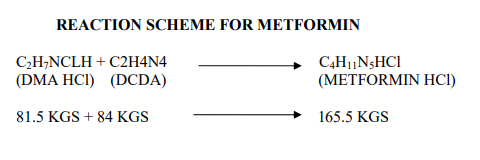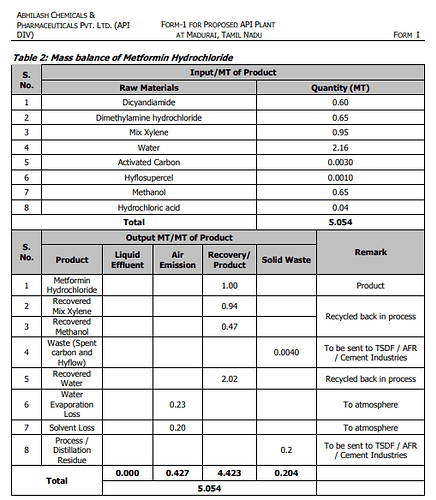Disc: I have bought over the last 45 days and it makes up >15% of my pf. I am not a SEBI registered advisor. Please do your own due diligence. This is not a buy/sell recommendation.
The rationale for buying Balaji Amines over Alkyl amines and at this specific juncture are as follows:
- BAL has 30,000 MTPA capacity of the key intermediate DMA HCL which is required for making Metformin API v/s 13,000 MTPA for Alkyl Amines.
- Lack of viable substitutes for DMF which is a key solvent for Pharma/Agrochemicals which satisfy the necessary technical/chemical parameters. Besides DMF capacity is possibly fungible and can be used alternatively for other methylamine derivatives.
- BSCL Capex done with the new products being import substitutes (EDA, DETA, Piperazine) or ADD imposed on them (MIPA)
Will go into detail about the first 2 points below.
Lack of substitutes for DMF
https://echa.europa.eu/documents/10162/13641/annex_restriction_dimethylformamide_en.pdf
Click on arrow to get more info
Taking into account the classification of the technically possibly suitable alternatives as compiled in Table B12, and the recommendations by Kerton and ICH (Table B13; Table B14), DMF cannot be reasonably replaced by most of the mentioned substances. NMP, HMPA, DMAc, HMPT, Benzene, Toluene, NEP, NMAc, Formamide, and 2-Furaldehyde are not suitable due to their classification as either Reproductive Toxicant or Carcinogen and/or Mutagen, as it is pointless to substitute DMF by another CMR substance. Although the solvent NBP has proven to be performing as a viable alternative in certain specific applications to existing dipolar aprotic solvents like NMP, NBP is not considered to be a replacement for DMF. The substantial difference in boiling point between DMF and NBP hinders a potential substitution for the aforementioned applications. Furthermore, both Acetonitrile and Tetrahydrofuran are listed as undesirable substance within the ‘green’ alternatives, and are mentioned as Class 2 solvent in pharmaceutical products, i.e. solvents which should be limited. Consequently, those solvent should not be considered as suitable alternative in terms of their intrinsic hazard, too. So, the only remaining substances are DMSO and MEK.
In consequence, regarding worker and consumer protection, DMSO should be the preferred alternative. Nevertheless, both solvents are already used in a number of applications, which are certainly posing suitable alternatives for DMF. However, those solvents are not generally able to replace DMF in all its applications.
Industry also indicated that DMSO is the main long-term alternative to DMF available on the market. Whilst DMSO certainly is not a dropin substitute for all applications, it has a broad spectrum of uses in which it could replace DMF, significantly reducing environment and/or health risk
Today it does not seem to be one single alternative that can replace DMF for all its uses, indicating that an authorization process would clearly eliminate several applications as authorization would make many processes no economically feasible anymore. However, within the above mentioned substances covering the major amount of the applications of DMF, and mainly due to classification issues, it became evident that DMSO is the only alternative relevant for further assessment, which will be performed.
Metformin (Possible Longevity Drug + Anti-Cancer adjuvant)
Approx between 0.5 to 0.65 MT of DMA HCL is required to make 1 MT of Metformin API.

Source: http://environmentclearance.nic.in/writereaddata/EIA/61110125912121214-2013.pdf
Other Sources
Source: http://environmentclearance.nic.in/writereaddata/Online/TOR/18_Jun_2016_1617110579E1MTQZDAnnexure-AdditionalAttachments.pdf
Below is the list of rated production capacities globally which i have gleaned from various filings and news reports.
| (in MT) | Production Capacities | |
|---|---|---|
| Aarti | 14400 | 20.06% |
| Granules | 14000 | 19.50% |
| USV | 10100 | 14.07% |
| Wanbury | 9000 | 12.53% |
| Harman Finochem | 6000 | 8.36% |
| Smruthi Organics | 4800 | 6.69% |
| Farmhispania | 4000 | 5.57% |
| IOL CP | 4000 | 5.57% |
| Vistin Pharma | 3100 | 4.32% |
| Sohan Healthcare | 2400 | 3.34% |
| Total | 71800 |
Excerpts from Vistin Pharma filings:
http://www.vistin.com/getfile.php/132303-1525862070/Documents/PDF/Vistin%20Pharma%20-%20Prospectus%20-%209%20May%202018.pdf
Actual metformin consumption in 2013 corresponded to ~50% of the diagnosed population and ~25% of total people with diabetes. The global market for metformin in 2016 was estimated to be ~40,000MT and is expected to grow by 2,000 to 3,000MT annually going forward. There are approximately 25 manufacturers globally with regulatory approval to deliver metformin HCl in the EU and the US. Approximately 65% of the volume is produced in India and there are only two producers in Europe. The current market for metformin is competitive and there is sufficient global capacity to absorb the volume growth as many of the plants producing metformin API are multi-purpose. This is particularly true for the plants in Asia.
8.4 COMPETITIVE LANDSCAPE
8.4.1 Metformin business
The global manufacturing of Metformin HCl is according to Vistin Pharma’s Executive Management approximately 40,000 MT per year, whereof Vistin Pharma is the fifth largest producer with a production volume in 2017 of approximately 3,100 MT (~8% of the global production). 65% of the global volume is manufactured in India.
Given the above commentary and BAL having double the capacity of Alkyl amines for DMA HCL, they are better placed to capture incremental growth of Metformin globally.
Why is Metformin a possible longevity/anti-cancer drug?
With the knowledge I have assimilated so far, one of the primary mechanisms through which Metformin affects the body’s metabolism is by weakly inhibiting Complex I of the ETC (Electron transport chain) in the Mitochondria.
Highly recommended to read Nick Lane’s Power, Sex, Suicide: Mitochondria and the meaning of life
A perfect illustration of one of 3 bucket’s (Biology - The most important bucket IMHO) illustrated by Peter Kaufman:
Every statistician knows that a large, relevant sample size is their best friend. What are the three largest, most relevant sample sizes for identifying universal principles? Bucket number one is inorganic systems, which are 13.7 billion years in size. It’s all the laws of math and physics, the entire physical universe. Bucket number two is organic systems, 3.5 billion years of biology on Earth. And bucket number three is human history, you can pick your own number, I picked 20,000 years of recorded human behavior. Those are the three largest sample sizes we can access and the most relevant. — Peter Kaufman
Also one can observe how nature/time is antifragile and the co-existence of mitochondrial DNA with nuclear DNA is a perfect example of complexity, feedback loops, redundancy and decentralization.
Additional Points
Complex life evolved after a chance event of one bacteria eating another bacteria (Mitochondrial ancestor).
Apart from nucleus, mitochondria is the only other cell organelle with its own set of DNA (13 genes specific to the various complexes in ETC).
Over a period of 2 billion years, nature acted on the competition between 2 competing genome to evolve the initial eukaryotic cell from amoeba to higher and higher complex life forms.
Though we all learn that Mitochondria is the powerhouse of the cell, it does far more than that. More important point being that without ATP the basic currency of life, nothing gets done.
Below set of podcasts go in depth on possible mechanisms through which Metformin affects the body.
Metformin in Longevity Study (MILES). (MILES)
Excerpts from above Clinical Trial
Several mechanisms have been shown to delay the aging process, resulting in improved healthspan in animal models, including mammals. These include caloric restriction, alteration in GH/IGF1 pathways, as well as use of several drugs such as resveratrol (SIRT1 activator) and rapamycin (mTOR inhibitor). At Einstein, the investigators have been working to discover pathways associated with exceptional longevity. The investigators propose the study of drugs already in common clinical use (and FDA approved) for a possible alternative purpose -healthy aging. The investigators goal is to identify additional mechanisms involved in aging, the delay of aging and the prevention of age-related diseases. In this proposal, the investigators explore the possibility of a commonly used drug, metformin, to reverse relevant aspects of the physiology and biology of aging.
Metformin is an FDA approved drug in common use in the US since the 1990s. It is the first-line drug of choice for prevention and treatment of type 2 diabetes (T2DM). The effect of metformin on aging has been extensively studied, and has been associated with longevity in many rodent models. Metformin also extends the lifespan of nematodes, suggesting an evolutionarily conserved mechanism. A recent high impact study demonstrated that metformin reduces oxidative stress and inflammation and extends both lifespan and health span in a mouse model .
There is also evidence from studies performed both in-vitro and in-vivo of metformin’s role in attenuating tumorigenesis. The mechanisms proposed relate to its effects on reducing insulin levels, improved insulin action, decreased IGF-1 signaling (central to mammalian longevity), as well as activation of AMP-kinase. In fact, metformin’s potential protective effect against cancer has been gaining much attention, with over 100 ongoing studies registered on the Clinical Trials.gov website.
To characterize pathways associated with increased lifespan and healthspan, the investigators plan to compile a repository of muscle and adipose biopsy samples obtained from young healthy subjects and older adults before and after treatment with potential anti-aging drugs. RNA-Seq analysis will be used to identify a unique biological “fingerprint” for aging in these tissues by comparing changes in gene expression in older adults post-drug therapy to the profiles of young healthy subjects. This overall approach is supported by a grant from the Glenn Foundation for the Study of the Biology of Human Aging.
The investigators believe that if metformin changes the biology of aging in tissues to a younger profile, it supports the notion that this drug may have more widespread use - as an “anti-aging” drug.


